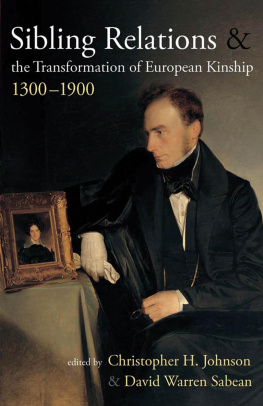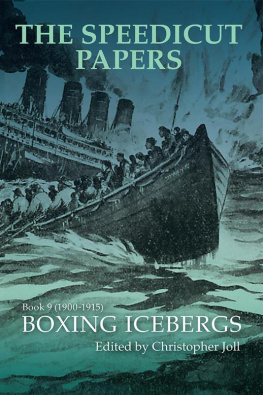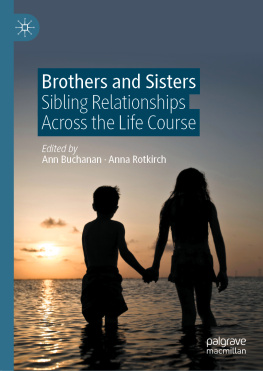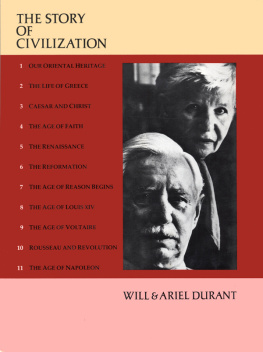Sibling Relations and the
Transformations of European Kinship,
13001900
We would like
to dedicate this book
to the memory of
Bernard Derouet
Sibling Relations and
the Transformations of
European Kinship, 13001900
Edited by
Christopher H. Johnson
and
David Warren Sabean
First published in 2011 by
Berghahn Books
www.berghahnbooks.com
2011, 2013 Christopher H. Johnson and David Warren Sabean First paperback edition published in 2013
All rights reserved. Except for the quotation of short passages for the purposes of criticism and review, no part of this book may be reproduced in any form or by any means, electronic or mechanical, including photocopying, recording, or any information storage and retrieval system now known or to be invented, without written permission of the publisher.
Library of Congress Cataloging-in-Publication Data
Sibling relations and the transformations of European kinship, 13001900 / edited by Christopher H. Johnson and David Warren Sabean.
p. cm.
Includes bibliographical references and index.
ISBN 978-1-84545-769-3 (hardback) -- ISBN 978-0-85745-046-3 (institutional ebook) -- ISBN 978-1-78238-087-0 (paperback) -- ISBN 978-1-78238-088-7 (retail ebook)
1. Brothers and sistersbEuropeHistory. 2. KinshipEuropeHistory. I. Johnson, Christopher H. II. Sabean, David Warren.
HQ759.96.S54 2011
306.875094dc22
2010029805
British Library Cataloguing in Publication Data
A catalogue record for this book is available from the British Library
Printed in the United States on acid-free paper.
ISBN: 978-1-78238-087-0 paperback
ISBN: 978-1-78238-088-7 retail ebook
Contents
Christopher H. Johnson and David Warren Sabean
PART ONE
PROPERTY, POLITICS, AND SIBLING STRATEGIES
(LATE MEDIEVAL AND EARLY MODERN)
Bernard Derouet
Karl-Heinz Spie
Michaela Hohkamp
Sophie Ruppel
Benjamin Marschke
Grard Delille
PART TWO
SIBLING RELATIONS, CLOSE MARRIAGE, AND HORIZONTAL KINSHIP,
17501900
Ruth Perry
Christopher H. Johnson
David Warren Sabean
Regina Schulte
Mary Jean Corbett
Leonore Davidoff
Figures and Illustrations
Figures
Illustrations
Preface
In 2007, Berghahn Books published Kinship in Europe: Approaches to Long-Term Development (13001900), edited by David Warren Sabean, Simon Teuscher, and Jon Mathieu. The chapters in that volume were gathered together from three conferences. In Oslo at the International Historical Association Conference in the round table session Family, Marriage, and Property Rights, we rather tentatively broached the issue of systematic structures of kinship in Europe and the problem of historic change from the Middle Ages through the long processes of modernization. Teuscher and Mathieu, together with Sabean, provided a number of panels at the European Social Science History Conference (ESSHC) in the Hague and went on to bring together seventy scholars and students at Ascona-Monte Verit, Switzerland.
The chapters in Kinship in Europe distilled the argument that emerged in the broad comparison of different, mostly Western European, regions and states. They outlined two major transitions in long-term transformations of kinship: one leading from the late Middle Ages into the early modern period, and the other beginning in the mid eighteenth century, working out its course during the first decades of the nineteenth century. Taking into account issues of political modernization, novel economic institutions, and class differentiation, the book documented shifts in kinship but by no means a decline in its importance.
The early comparative work faced many difficulties, not the least of which were the radical differences in the way different countries treat the history of kinship and the family. Some of the most systematic work on kinship emerged earlier in France than anywhere else, and two French historians have been central to our discussions: Grard Delille, whose detailed and magnificent work on kinship systems in Italy has provided a challenge to continually rethink the issue of structure, and Bernard Derouet, whose work on inheritance systems in France has revolutionized the field.
The first results of discussions from the three conferences provided both a historical grid and a series of theoretical issues. The next years brought new constellations of scholars together to test and broaden our hypotheses and to provide new departures for consideration. Since we were also reflecting on more than a century of social anthropological research on kinship, mostly in non-European areas, we were anxious to consolidate first our understanding of Europe before slowly expanding our geographical coverage. For some of the problems we took up, we gingerly began to step into the twentieth and twenty-first centuries and push back our examination to the ancient world. At the ESSHC in Berlin, we looked at sibling relationships. Here we were most interested in testing and revising the view of kinship over the long run. Many of the essays in this volume were first presented in Berlin, and the editors have rounded out the discussion with a number of solicited manuscripts. At that conference, Simon Teuscher and Jon Mathieu played a major role in setting a high intellectual and critical tone.
At the ESSHC in Amsterdam, we brought together six panels to discuss international families, once again beginning in the Middle Ages but this time going on into the twentieth century. Here we were concerned less with expanding on a narrative of long-term structural changes than with thinking through the use of certain conceptual tools. On the basis of many decades of work on the family and kinship in Europe, the task was to consider issues of systemic family relations, power and coordination of interests, and material mediationswhat kinds of services, properties, activities, and cultural goods help give shape to how family members and kin relate to one another. The German Historical Institute in Washington provided a venue for a follow-up conference, and the revised essays are collected in a volume in preparation, edited by Johnson, Teuscher, Sabean, and Francesca Trivellato.


















